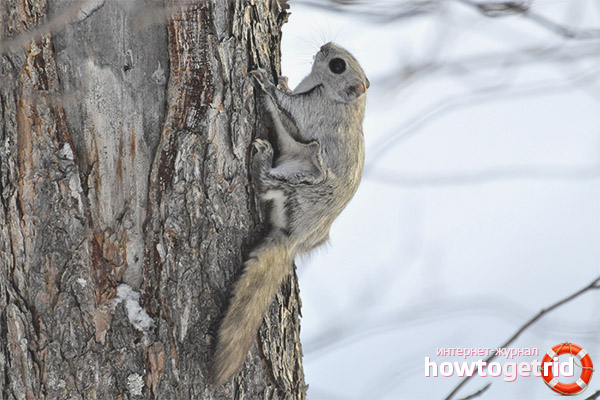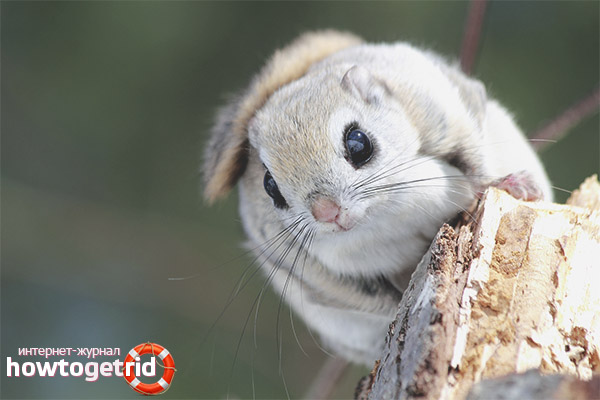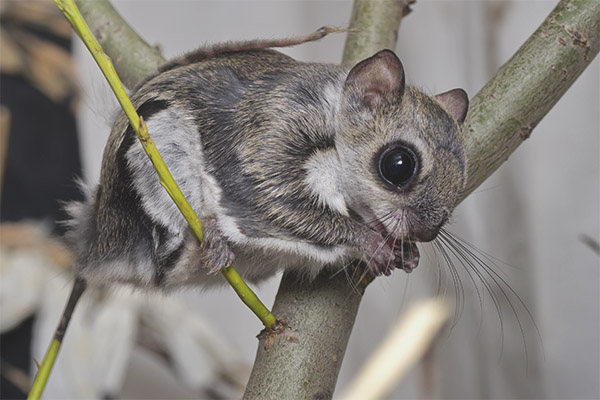The content of the article
The flying squirrel is a tiny rodent. It belongs to the squirrel family and is the only representative of the family of youngsters who can live in the climatic conditions of Russia. This article will allow you to learn about the habits of the flying creatures, as well as tell you various interesting facts about these unusual animals.
general description
The flying squirrel is a small animal with a body length of up to 17 cm and an average weight of 125 g. Its tail is rather long compared to the body and is 12 cm. The leathery fold located along the body serves for planning and jumping. Covered with fine wool, it connects the fore and hind limbs and straightens when the squirrel jumps. This membrane is used as a simplified version of the parachute.The flight length of flying squirrels can be 50 meters along a parabolic curve.
From the wrist flying squirrels a small crescent bone, supporting this fold. The surface of the tail is covered with thick fur. The head of the flying squirrel is more rounded than the head of an ordinary squirrel, and the ears do not have brushes. Shiny black eyes are surrounded by dark fur. There are 22 teeth.
The large size and protuberance of the eyes make it possible for the nightclub to fly. Soft thin coat becomes thick and dense for winter. The color of the skin on the back is silver and on the abdomen is gray with a yellow tint. The tail gray has a black border. Its main color is lighter than the color of the rest of the body. The tail has a slight combing of wool to the side of the center.
With the change of the season, the color of the fur is also changing, becoming lighter in winter. Twice a year, animals molt. Autumn shedding starts from the head and stops at the tip of the tail. Spring molt proceeds exactly the opposite, starting with the tail and ending at the crown.
The elongated bones of the limbs, especially the legs and forearms, are necessary for flying to move between trees. Its paws are quite developed and very tenacious, and the hind ones are noticeably longer than the front ones. There are 4 fingers on the fore limbs, 5 fingers on the back.In the sitting position, the animal throws its tail on its back.
Territorial distribution
From the inside, such a nest has a spherical shape in winter, and in summer the layer of litter is significantly reduced. Outside, the hollow is greasy and spattered with scraps of wool. In the western part of Russia, flying squirrel is trying to settle near the marshland where the alder grows. Also, the animal prefers lakes and rivers, where there are old hollow trees.
Nutrition
The main occupation of flying squirrels is the search for food. Most of its food consists of various plants and buds of trees. Earrings of birch and alder - a favorite delicacy of this animal. She even makes stocks for the winter, hiding earrings inside her nest.In summer, mushrooms and berries, as well as young shoots are included in the summer food.
There is an assumption that flying squirrels are capable of eating chicks and eggs of small species of birds. But the main factor affecting the diet of the animal, is the area of distribution. In the north and west of Russia, the flying squirrel is satisfied in the winter only with the stored buds of larch.
Lifestyle

The flying squirrel leads an evening lifestyle. But nursing females and young animals love to spend time outside in daylight. The animal retains activity throughout the year, not being able to hibernate. Most of the time flying squirrels spend on the branches of trees and reluctantly descend down.
They are difficult to see with the naked eye because of the coloring, which helps them to be invisible against the background of the trunks and leaves. But late in the evening, the peak of vital activity begins near the flyers, and then you can hear their voice, like a low chirping and clattering. The same sounds of flying squirrels emit during games, and also if the animal is excited or frightened.
It is common for flying proteins to live in the same place. They rarely change the habitat to which they are tied, and can live for several years in the same hollow.For the flying squirrel, having changed its usual place, not only hollows can serve as a new house, but also birdhouses, empty beehives, bird nests.
The radius at which the animals move away from their home in search of food is not particularly large - 50-100 meters. They have established feeding routes. Often, one such route provides food to more than one generation of flying squirrels.
During winter frosts, the activity of animals decreases. Although the flying squirrel does not hibernate, she spends most of the day in the hollow, eating previously prepared supplies. Siberian flying squirrel has the ability to sleep for several days in a row, escaping from the cold weather. The usual wakefulness in summer is 8 hours. In the spring, this figure increases to 11 hours due to rutting and mating.
Social features and reproduction
Flying squirrels, as a rule, live in nests together. They do not change their pair throughout their lives and, as a rule, do not enter into conflicts. Flying squirrels do not show aggression towards each other, but a nursing female may show character, protecting the young.
Reproduction of flying has been little studied. During the year, the female has only one childbirth, and the number of litter is 2-4 cubs. The duration of pregnancy is 4-5 weeks. The first brood is born in April or May. The time for the second is the end of June-July. The care of the cubs is provided exclusively by females, they also teach them routes to accessible sources of food.
The flying squirrels that have just been born have a size of up to 5 cm and a weight of up to 7 g. The tail length of newborns does not exceed 1.4 cm.
In the first days of their life, the young are blind and naked, they gain sight on the 15th day. Young for the first time out of the nest after a month and a half after birth. 2-3 days after this event, young flying squirrels make their first jumps, and on the 50th day - the first planning. From this point on, they become completely independent and begin to live separately from their parents.
But, if the time of growing up had to be during the period of the coming frosts, the young offspring will stay with their parents in the winter, often staying overnight in the same hollow.
Longevity of captivity in captivity can reach 13 years, and in natural habitat animals rarely live longer than 5 years. Their main enemies are large birds of prey.Also flying squirrels stay away from martens and sables.
Human interaction

Despite the beauty of their skins, flying squirrels are not used in the fur industry, since the product from it will soon lose strength and peel off. You can not keep flying houses at home, because they need to make jumps, and the limited space of housing does not allow it to lead a normal life, because the animal soon dies.
But nothing prevents their breeding in zoos. This requires spacious aviaries. In order to preserve reproductive activity, lethal species require seasonal temperature changes. Therefore, the offspring is expected only from the animals contained in street enclosures.
Usually flying squirrels do not show aggression towards a person and tend to remain unnoticed by him. However, there are cases when females attacked people who disturbed offspring.
Sometimes flying squirrels settle near human habitation. In winter, they come to feed on grain.
Number of
The number of flyers is declining everywhere, and this sad trend continues. The hunt for them is limited.Flying squirrel in the Red Book of Belarus, belongs to the third category of protection. This means that special measures are necessary for the survival of the species.
Interesting Facts
- When a squirrel finds a nut, it breaks it down to reach the core. The flying squirrel drills a hole in the shell for this purpose.
- When planning, the body of the animal forms a trapezoidal silhouette. The tail and hind limbs are pressed to each other, the front legs are widely spaced. Changing the tension of the membranes allows the flyer to perform pilot maneuvers and rotate the body 90 degrees. Brake the animals with the help of the tail. For landing, the flying squirrel lands on the trunk of a tree with all four limbs and moves to its opposite side. Thanks to this action, it will be protected from large birds of prey.
- Traces of flyers are almost impossible to disassemble on the ground, since flying squirrels very rarely go down. The traces left in rare cases differ little from squirrel. Even an expert does not always see the difference.
- Before jumping, the flying squirrel rolls up into a small lump and then, with his limbs resting on a tree, sharply straightens his body and directs his paws forward.During the flight, the body area is doubled due to the straightened skin fold.
- While planning and jumping, flying squirrels do not make noise.
- There is a way to detect the presence of flyers - small piles of orange litter, similar to ant eggs.
- Flying squirrels are very clean animals. They devote a lot of time, licking their fur to shine. Particular attention is paid to the paws and tail.
- The first fossil leftovers belong to the geological epoch of the Miocene (23 million-5 million years ago).
- Flying squirrels are extremely cautious animals. But this quality is lost by them during the rut and search for a partner. During this period, they make a lot of sounds and fearlessly show on other people's eyes.
Video: common flying squirrel (Pteromys volans)












To send